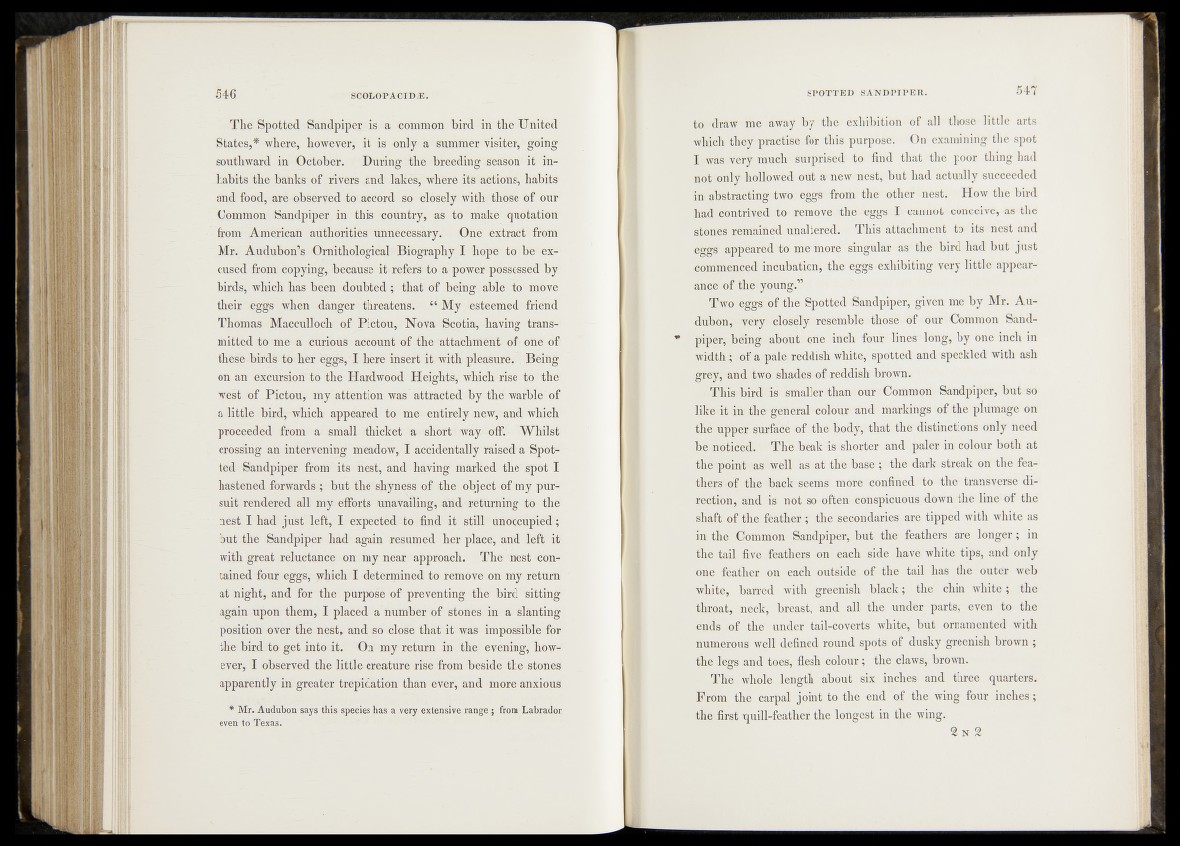
The Spotted Sandpiper.* is •• a common bird in the United
States,* -where, however* it is only a summer visiter, going
southward in October. y During the -'breeding season i i n habits
the-banks of rivers and lakes,'where its actions, habits
and food, are observed-to<'accord so closely' withV’thbse -Of our*
Common Sandpiper, in this country, ais lto vmake quotation
from American authorities unnecessary. One extract frbm'
Mr. Audulon?s Ornithological ^ Biographyhope|t%*fe%x-
cused from copying, because 'itireferSftb a-power possessed fe-jf#
birds, whi'ch has been doubted ; -that of being able tbWh'0've
their eggs when danger threatens. My i|MCm'ed Trie'nd'
Thomas Maccullochyof Pictou, Mova^cq't-ia, ^having *trans-'
mitted to'me a curious account of the attachmehtbab* one ©fi
th|fiJbiid& to her egg^-Hdime^ insert it'with ;Sfemg
on an- excu-rsiorPEo the Hardwood HetglM,' wM^^is%’^ ’bth'e*
west I # Pictou, my attention was "'attracted byljiijp warWn of
a Ettle bird*-which appeared to me^entiMymewj ’S&d which'-
proceeded from a small thicket a “short? WayJ off.- -Whilst1
crossing an intervening meadow, Pacfcidonhelily '-raided1 a* Spot4-^
ted Sandpiper, from' itssffest* and having^ marked^heiSp'Ot"IB.'
hastened forwards ; the^shyness'-of’ the? ©j||?mp|of tiry p’tir%
suit rendered all my efforts unavauing, and returning.%0 the
jxest I had? justTleft, I expected it©.;, find -it: stilluncoupled';
but the Sandpiper* had .again resumed her^place, 'arfd left5 it
with great ’reluctance on' my near approach. Th^raew contained
foureggs, which Tdetermined? to rem^^Mn'iin^rettfrn'
at'night, and forThe* purpose pjl preventing the bird sitting?
again upon them, I placed a number of stones* in a slanting
position over the nest, and so close that it was impbS^Metfor
the bird to get into it. On my return in the evening, hoW^
ever, I observed the little- creatiire rise from beside the stOUee
apparently, in greater trepidation than eye^, and more anxious
* Mr. Audubon says this species has a very extensive raijge^ from Labrador
“ even to Texas;
to draw me away by the exhibition of all those little arts
which they practise for this purpose. On examining the spot
I was- very much' surprised to find that the poor thing had
not-Only hollowed out a new nest, but had actually succeeded
in abstracting 'two eggs from the other nest. How the bird
had’Contrived to remove the eggs I cannot conceive, as the
Stones remained unaltered. This attachment to its nest and
eggs- appeared'to me more singular as the bird had but just
commenced innubationpthe eggs exhibiting very little appearances
© f the?yo.unglf^
Two'eggs' of the Spotted Sandpiper, given me by Mr. Audubon,
Iv^r-y mlosely^resemble those of our Common Sandpiper,*
being • abaht * one inch four lines long, by one inch in
width; of a pale reddish white,Spotted and speckled with ash
grey*- and two- shades -of reddish brown.
-..Thitfbirdi-is smallerbhan our-Common Sandpiper, but so
lfke-it in the^goiieral^coldurrand markings of the plumage on
thi-upper surface of thb4§odjf*t that the distinctions only need
bemol-ieblk The beak is shorter* and paler in colour both at
thtispoiiit-'*as1 Well as-at* the base ; the dark streak on the fea-
thersiof the back seems more confined to the transverse di-
recti!( S and is not so-often conspicuous down the line of the
shaft of the feather; the secondaries are tipped with white as
in thmCommon Sandpiper, but the feathers are longer; in
the tail five feathers on each side have white tips, and only
| | | e feather on each outside of the tail has the outer web
white, barred with greenish black; the chin white; the
throat, neck, breast, and all the under parts, even to the
ends of the under tail-coverts white, but ornamented with
numerous well defined round spots of dusky greenish brown ;
thjidlgs and toes, flesh colour; the claws, brown.
- The whole length about six inches and three quarters.
From the carpal joint to the end of the wing four inches;
the first quill-feather the longest in the wing.
2 n %